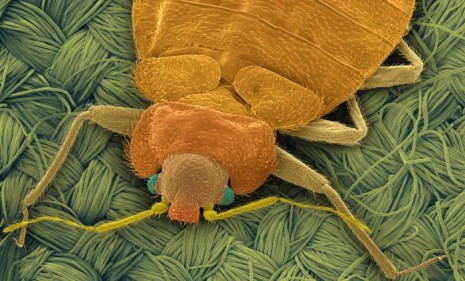The bedbug epidemic: How much of it is paranoia?
Bedbug infestations are no joke, says Eliza Barclay at Slate, but the surging pest control industry has a vested interest in promoting a better-safe-than-sorry mentality

The "bedbug panic" is at an all-time high, writes Eliza Barclay at Slate. And the recent "flurry of high-profile infestations at prominent movie theaters, retail shops, and hotels" is making it worse. The fear of these disgusting pests only grows once they've taken sanctuary in your mattress and gulped your blood at night. I know. After I summoned a "pest management technician" to banish them from my home with a trio of invasive chemical treatments, I grew paranoid. When I next found a suspect insect, my exterminators assured me it was a bedbug and I prepared to endure the ordeal again, until an esteemed entomologist overrode their diagnosis: My invader was a black carpet beetle. The emotional cost of such "false alarms" is steep — lost sleep, "anxiety," "angst." Bedbug "misdiagnosis," it seems, may be an even bigger problem than the real thing. Here, an excerpt:
The pest management industry is one that would benefit handsomely from an epidemic of false alarms. Treating a one-room apartment typically costs hundreds of dollars; for a single-family house, the bill might reach several thousand dollars. According to the National Pest Management Association, exterminators made $258 million from bedbugs in 2009, up 263 percent from three years before. That creates a major incentive for stoking idle fears and promoting a radical "better-safe-than-sorry" approach to the problem....
It's the "better safe than sorry" mentality that has people pursuing full treatments before their infestations have been confirmed by an authoritative entomologist. Even skeptics may be overcome by feelings of disgust or fear of being ostracized. And they're persuaded to call in the men (or women) in protective suits with spray hoses, terrified by the possibility of infecting friends and loved ones.
The Week
Escape your echo chamber. Get the facts behind the news, plus analysis from multiple perspectives.

Sign up for The Week's Free Newsletters
From our morning news briefing to a weekly Good News Newsletter, get the best of The Week delivered directly to your inbox.
From our morning news briefing to a weekly Good News Newsletter, get the best of The Week delivered directly to your inbox.
Read the full article at Slate.
.....................................................
SEE MORE OF THE WEEK'S COVERAGE OF BEDBUGS:
• America's bedbug invasion: By the numbers
A free daily email with the biggest news stories of the day – and the best features from TheWeek.com
• 7 high-profile New York City bedbug scares
-
 Bridget Riley: Learning to See – an ‘invigorating and magical ensemble’
Bridget Riley: Learning to See – an ‘invigorating and magical ensemble’The Week Recommends The English artist’s striking paintings turn ‘concentration into reverie’
-
 ‘Stakeknife’: MI5’s man inside the IRA
‘Stakeknife’: MI5’s man inside the IRAThe Explainer Freddie Scappaticci, implicated in 14 murders and 15 abductions during the Troubles, ‘probably cost more lives than he saved’, investigation claims
-
 The UK’s best Christmas pantos
The UK’s best Christmas pantosThe Week Recommends Dive into the festive cheer, even into the new year, with some traditional favourites and modern twists